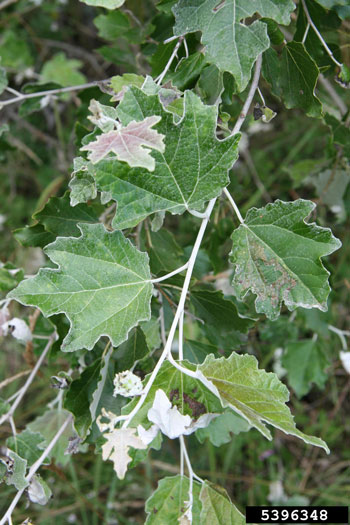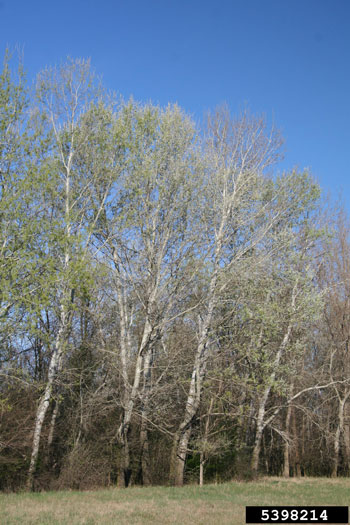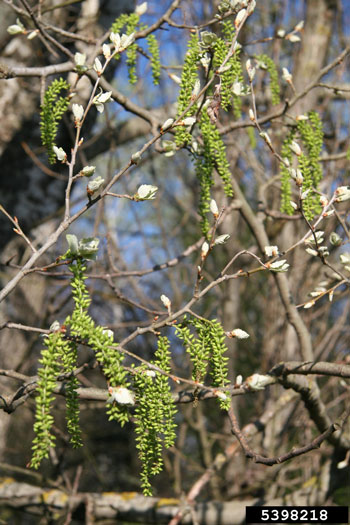DACF Home → Bureaus & Programs → Maine Natural Areas Program → Communities, Plants, and Animals → Invasive Plants → White Poplar
 White poplar leaves, note fuzzy white underside, Robert Vidéki, Doronicum Kft., Bugwood.org
White poplar leaves, note fuzzy white underside, Robert Vidéki, Doronicum Kft., Bugwood.org
White Poplar
Populus alba
2019 Status in Maine: Localized. Severely Invasive.
Description: Deciduous, fast growing, short-lived tree; prone to stump sprouting and clonal spread. Leaves: Alternate, simple, ~4" long, with 3-5 palmate lobes, like a maple leaf. Undersides are covered in dense white hairs. Flowers/Seeds: Dioecious; most specimens in North America are female. Flowers are green (reddish green in males), arranged in pendant clusters (catkins) several inches long, and appear before bud break. Like other poplars, female catkins become cottony, releasing tiny fluff-covered seeds. Stem: White down covers new branch growth. Bark is whitish to pale gray, becoming darker and rough on lower trunk with age. Roots: Deep and fibrous. Lateral root suckering can be extensive.
Native range: Central and southern Europe, temperate Asia, northern Africa. How arrived in U.S.: Introduced as a landscape tree, recorded in New England as early as 1785.
Reproduction: Primarily by vegetative means. Lateral roots can cover considerable distance below ground, with suckers emerging ove r100' from the parent tree. In some situations, dense colonies can form. Stem and root fragments have also been shown to regenerate the plant. Flowers are wind pollinated, but since males are rare, seed production occurs mainly through hybridization with other poplar species. The resulting hybrids can be female, male, or hermaphrodites, and can produce large numbers of viable, wind-dispersed seeds.
Habitat: Commonly found where soils are deep and moist: floodplains, lake shores, swamps, and abandoned farmland.
Similar native species: Quaking aspen (Populus tremuloides), eastern cottonwood (Populus deltoides), and balsam poplar (Populus balsamifera) all lack the silvery white hairs on branches, leaves, and buds. These native poplars have unlobed leaves and pointier, glabrous leaf buds.
Similar non-native species: None.
Documented Ecological Impacts
 White poplar tree, Robert Vidéki, Doronicum Kft., Bugwood.org
White poplar tree, Robert Vidéki, Doronicum Kft., Bugwood.org
- Ecological impacts of white poplar do not appear to be well-studied despite its presence in North America for over 100 years.
- White poplar outcompetes many native tree and shrub species by forming large colonies in sunny areas such as forest edges and fields which interferes with the progress of forest succession. (White Poplar Factsheet, Plant Conservation Alliance)
- White poplar hybridizes with several other native Populus species, producing vigorous hybrids. When cut, white poplar produces many root suckers which can interfere with forest succession. (Gucker, C.L. 2010. Populus alba and hybrids. In: Fire Effects Information System, U.S. Department of Agriculture, Forest Service)
- White poplar is known from riparian areas in its native range of western and central Europe, as well as in North America, and thus has the potential to invade Maine’s floodplain forests. Since these are rare habitats, invasions there are of top concern for conservation of biodiversity.
Fact Sheets and Identification Links
- White poplar fact sheet, Plant Conservation Alliance
- White poplar fact sheet, Vermont Invasives
- Populus alba identification video, Duncan Slater, Arbor Day UK (1:52)
- Trees with Don Leopold-white poplar, SUNY CESF (2:03)
- Go Botany Webpage for white poplar
Control Methods
Girdling and cutting promotes vigorous resprouting and lateral suckering, so repeated treatments will be necessary*. Foliar application of a triclopyr or glyphosate solution † is effective on seedlings and small trees. For larger trees, consider the cut-stump method using a more concentrated solution of triclopyr or glyphosate, or basal bark treatment using a triclopyr ester solution in bark oil.
* Correctly dispose of all plant parts↵ † Follow all label directions when using herbicides↵Control Technique Links
- Vegetation Management Guideline for White Poplar, Illinois Natural History Survey
- Hack and Squirt Treatment video, University of Kentucky Forestry Extension (3:53)
 White poplar catkins, Robert Vidéki, Doronicum Kft., Bugwood.org
White poplar catkins, Robert Vidéki, Doronicum Kft., Bugwood.org
Please email invasives.mnap@maine.gov if you have questions about invasive species in Maine